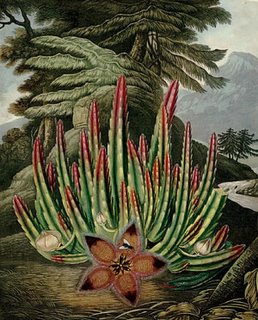The grandiose vision of botanist Dr Robert Thornton (1768-1837) was to restore Britain to her rightful artistic place, ahead of France and Germany, with the release in subscription form of his opus, The Temple of Flora, over a few years at the beginning of the 19th century.
Thornton inherited the family fortune in 1799 which allowed him to leave medicine and concentrate on his botanical interests. Royal patronage, world exploration and specimen collection and a quest for scientific knowledge encouraged an expansion in botanical illustration.
Thornton's plan, in part a homage to Linnaeus, was to release a 3 volume set divided into sexual characteristics, nomenclature and his beloved images. The best artists and engravers of the day were commissioned. Thornton himself was the artistic director but he also contributed some painting and engraving to the enterprise.
Unfortunately, war broke out and coupled with a downturn in interest for such an elaborate publication, great financial losses were sustained. Despite running a lottery for a smaller quarto edition, the venture ultimately sent Thornton bankrupt and he was destitute at the time of his death. From a proposal that included 70 illustrations, a total of 33 hand-coloured mezzotint engravings were eventually completed by 1807.
The embellished and at times surreal nature of the images were to be the lasting value of Thornton's Temple of Flora. Unusually, specimens were portrayed in unnatural landscape settings which Thornton wove in as part of the text, reducing the scientific importance even further. For one image he wrote: "The clouds are disturbed, and every thing looks wild and sombre about the dragon ARUM, a plant equally poisonous as fetid."
- All of the images from The Temple of Flora are displayed at the Audubon House Gallery of Natural History - (the above images come from here)
- Another complete set of Flora plates at Arader Galleries (if you like the images above, it's worth looking at both sites simply because there are differences in brightness and colour from variation in print runs and imaging techniques)
- Audubon Gallery biography of Thornton and account of the book preparation.
- Some more information from George Glazer Gallery.

















































5 comments :
The Night-Blowing Cereus illustration graces the cover of a book I own—a translation of García Lorca’s Poema del Cante Jondo. I admit that I hadn’t wondered where this picture originated, but I’m glad to know about it now. These (as usual) are wonderful images—thank you.
I had a bit of a deja vu moment when I first saw a few of the flowers. No doubt many of them grace the covers books. (I'm sure someone out there must compile stats about origins of bookcovers?)
And of course, poster sites dominate search results. I seem to recall seeing the full set of 33 prints available for $US12,000.
oh...for a love of eclectic images and illustrations, your blog is a dream come true. I'll be sure to post and pass the word...thanks!
kelly
This title is online at Botanicus, the Missouri Botanical Garden's Digital Library Portal.
I love the rare flowers and I'm definitely coming back. You have a great blog.
Post a Comment
Comments are all moderated so don't waste your time spamming: they will never show up.
If you include ANY links that aren't pertinent to the blog post or discussion they will be deleted and a rash will break out in your underwear.
Also: please play the ball and not the person.
Note: only a member of this blog may post a comment.